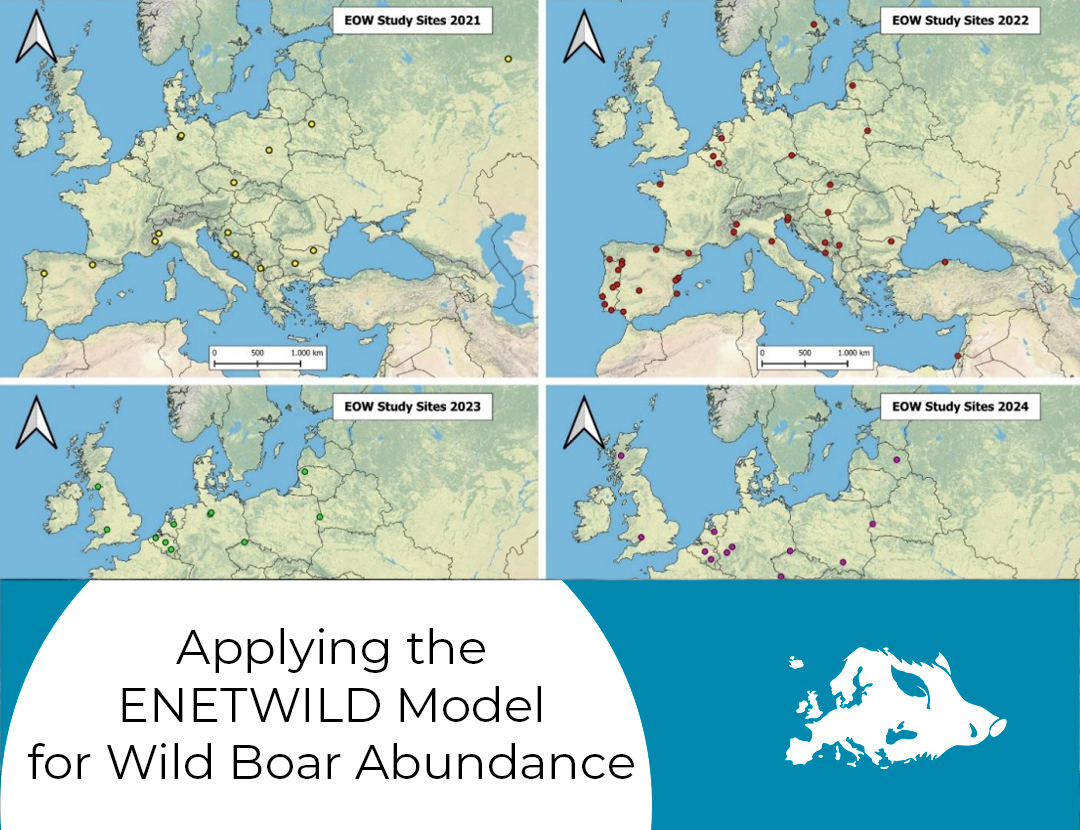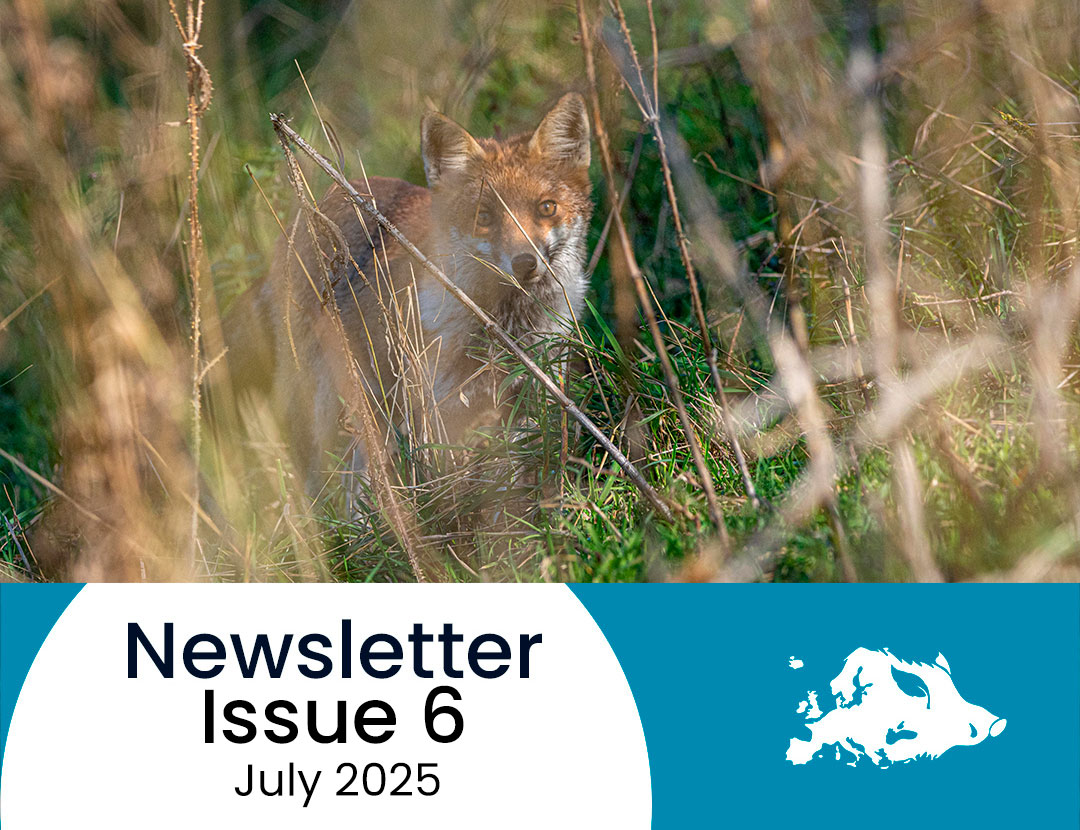Welcome to the ENETWILD Newsletter!
ENETWILD is an international network of wildlife professionals focused on integrating wildlife management with pathogens’ surveillance and management. The project is funded by EFSA.
In this newsletter you will stay in the loop on the latest publications and updates in the wildlife world, you will have access to event information and will get to know more about the people involved in the project.
Latest publications

📸 Camtrap DP: an open standard for the FAIR exchange and archiving of camera trap data ➡️ https://zslpublications.onlinelibrary.wiley.com/doi/10.1002/rse2.374
🐗 Update on available data on wild boar population and ASF epidemiology ⬇️ https://zenodo.org/records/10527290
🔎 Detection of African swine fever virus and wild boar eDNA in soil and turbid water sample towards environmental surveillance ⬇️
https://link.springer.com/article/10.1007/s10344-023-01758-z
📋 Effectiveness of methods for controlling wild boar movement (wild boar separation): protocol for literature review and scenarios definition ⬇️ https://zenodo.org/records/10516616
🩺 One Health: A Holistic Approach To Communicating About Global Health Issues ➡️ https://www.stonybrook.edu/commcms/alda-center/thelink/posts/one_health.php
🧬Development of a qPCR Duplex Assay for simultaneous detection of Fascioloides magna and Galba truncatula in eDNA samples: Monitoring beyond boundaries⬇️ https://www.sciencedirect.com/science/article/pii/S004896972400473X?via%3Dihub
Events

12-14 April Cambridge, UK
Mammal Society’s 70th Anniversary Annual Conference

22-24 April Turin, Italy
Measurements and applications in veterinary and animal sciences

17-21 June Bologna, Italy
7th European Congress of
Conservation Biology

3-5 July Pesche, Italy
XIII National Congress of the Italian
Mammal Society

9–13 September Hybrid format – Stralsund, Germany
5th European Wildlife Disease Conference
Updates
African Swine Fever (ASF) has been raising concerns in Europe since its introduction in 2014. More recently, the ASF epidemic has reached alarming levels in Italy, spreading to the regions of Lombardy in August 2023 and Emilia Romagna in November 2023. These occurrences have sparked significant concern within the country’s pig sector, particularly given the importance of these regions in both pig farming and processing industries. The spread of ASF in these areas underscores the urgent need for comprehensive measures to contain its expansion.
After its initial appearance in north-west Italy in early 2022, the ASF made long-range jumps that involved wild boar and pig populations in the Rome area in May 2022, before spreading further south to Calabria in April 2023 and Campania in May 2023 (map). These patterns of transmission highlight the role of human activities in propagating the virus.
Although harmless to humans, ASF can be deadly for pigs and wild boar, with conspicuous socio-economic consequences for affected countries (more info on the EFSA website). Efforts to address the ASF threat in Italy have focused so far on increasing farm biosecurity and reducing wild boar numbers. However, it is necessary to undertake broader initiatives, including raising awareness across various sectors, implementing active surveillance measures, and monitoring wild boar densities. These measures are essential not only for containing the current outbreaks, but also for preventing future incursions of the disease.
Interview
Relax and enjoy this interview with the new ENETWILD Consortium coordinator, Ezio Ferroglio from Università di Torino.

Could you start telling us a bit about your role in the project?
As the coordinator of the second ENETWILD project, I’m overseeing the consortium. This comes with significant challenges, given the substantial growth of the consortium and heightened expectations from EFSA, partners, and stakeholders. Effectively managing the demanding EFSA requirements is a substantial challenge, alongside the coordination of collaborative efforts among colleagues spanning over 27 institutions.
Why does the project ENETWILD motivate you?
Similar to numerous other colleagues engaged in wildlife disease research, I have, in the past, sensed a lack of adequate consideration for this topic by institutions. ENETWILD presents a fantastic opportunity to address this gap and contribute our scientific knowledge to inform decision-makers at the European Union level.
What are the project’s initial aims and how have they evolved?
Given the insufficient data available on the abundance and distribution of wildlife populations, the primary objective in the initial contract was to gather information and establish a system for harmonizing data on wildlife populations. This involved collecting data, developing monitoring tools and establishing a network of collaborators aimed at addressing this informational gap. While the health aspect was only incorporated towards the conclusion of the initial contract, it served as the foundation for the development of the second call.
Entering this second call, what are the key changes to the project’s scope?
In this latest call and contract, the emphasis on the One Health perspective is evident right from the title “Wildlife and One Health”. The shift has occurred from focusing solely on wildlife populations to addressing topics related to wildlife health. This comprehensive approach integrates wildlife ecology, health surveillance, and interactions with livestock, human populations, and the environment. This significant leap forward has been facilitated by the groundwork laid during the initial contract.
Are there any specific innovations incorporated into the new aims?
Certainly, there are quite a few. Our new responsibilities include a communication task that was absent in the previous contract. Additionally, the consortium now includes social scientists who will play a crucial role in disseminating tools and results from past efforts. They will also analyze new data, taking into account the human perspective, to enhance the implementation of results in decision-maker’s strategies.
What inspired the expansion of the project’s scope?
In recent years, global awareness of the risks posed by wildlife diseases to both domestic animals and humans has significantly increased. The African Swine Fever epidemic impacting wild boars in numerous European countries, along with the Covid-19 pandemic, may have expedited the recognition of the imperative to incorporate wildlife health surveillance into the EU health system.
Have any new collaborations or partnerships been established due to the revised aims?
Yes, we have increased the number of partners from 16 to 27 to be able to meet the EFSA requirements in terms of topic and related reports within the allotted timeframe (usually limited), the coverage at the national level as well as the background and skill of new partners.
How do these collaborations contribute to achieving the project’s goals?
Shifting the focus of the consortium’s efforts towards wildlife disease risks and management has broadened our expertise. We have welcomed colleagues specializing in infectious diseases and social sciences, enhancing our capabilities not only in data analysis and interpretation but also in understanding the human dimension of wildlife and wildlife disease management. This includes incorporating human behavior into management practices and communication. Notably, we have enlisted partners with expertise in communication to effectively convey knowledge and guidance to stakeholders.
What are the next expected impacts?
The expectation from all of us is that the outcomes, which are of the public domain, will be transferred to institutions and used by them and by stakeholders because we need to improve the management of wildlife and wildlife disease-related topics for preserving wildlife and human health.
What would you like ENTEWILD to accomplish in the end?
Transitioning wildlife and wildlife disease management from merely a “research topic” to well-founded policies implemented by the EU, European states, and stakeholder associations.

Anything you would like to highlight for the readers of the newsletter?
Given the concerns surrounding wildlife disease-related issues and their potential risks to public health, there are high expectations from EFSA, partners, the European Commission, member states, and stakeholders. As ENETWILD, we serve as a valuable tool to address and elucidate these challenges. I am optimistic that stakeholders will make the results of our efforts their own.
New website!
Our website is getting a new look! It will be live soon. Here’s a sneak peek!





